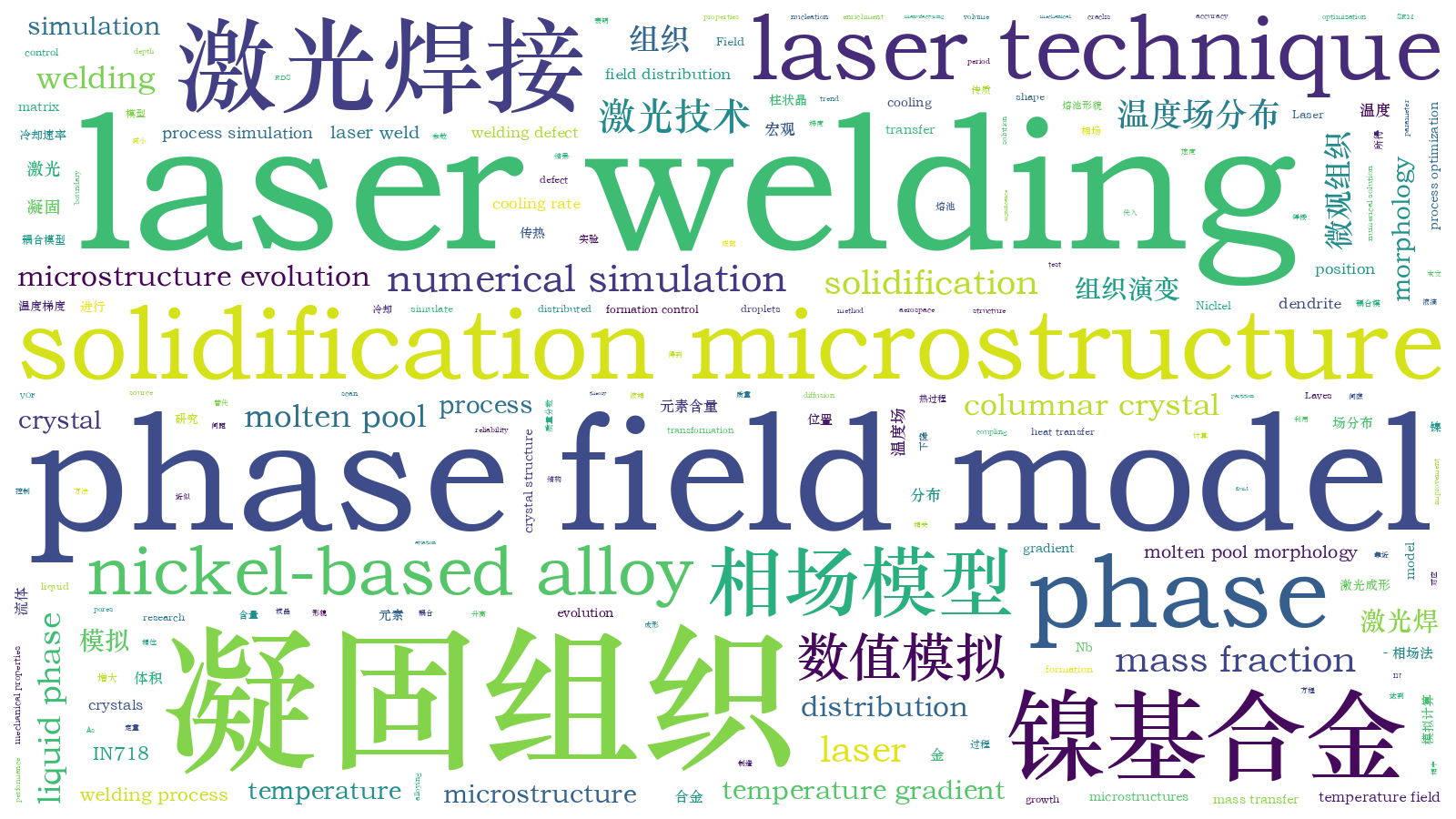镍基合金激光焊凝固组织流体体积法‑相场法研究
Laser utilization as a heat source to connect nickel-based superalloys has been applied in aviation, aerospace, weapons manufacturing and other fields. Solidification behavior of the laser welding molten pool of nickel-based alloys, including the nucleation, growth, collision and movement of grains, and the diffusion, enrichment and segregation of alloying elements, directly affect nickel-based alloy laser weld performance. Therefore, in-depth research of the solidification behavior of the nickel-based alloy laser welding molten pool is of paramount significance, particularly for laser welding process optimization, welding defect formation control, and the improvement of laser weld mechanical properties.
The macroscopic heat and mass transfer coupling model alongside microstructure evolution is utilized to quantitatively simulate the macroscopic heat and mass transfer, and the microstructure evolution of a laser welded IN718 alloy. The fluid volume (VOF) method is used to simulate the molten pool morphology and temperature field distribution of the macroscopic heat transfer process, and the temperature field distribution replaces the solidification parameter variables relating to the phase field control equation and is brought into the phase field model for microstructure evolution process simulation.
The simulated and experimental microstructures are shown in Fig.6, where it can be observed that all tissues are columnar crystal structures with a consistent morphology. As shown in Fig.7(a), the solidification velocity R and temperature gradient G at different positions were extracted in the macroscopic simulation results. The solidification velocity R gradually decreased from top to bottom with the molten pool boundary, and the temperature gradient G gradually increased. The cooling rate G·R showed a decreasing trend, the dendrite spacing gradually increased, and the results are shown in Fig.7(b). Compared with the Hunt and Kurz et al. numerical models, the phase field model calculated results are more accurate and close to the experimental results, showing consistent regularity, as shown in Fig.8. The distribution of Nb elements perpendicular to the growth direction of columnar crystals in the simulation results is shown in Fig.9 (b), this shows obvious periodic changes, and the change period is closely related to the phase morphology, because the IN718 solute partition coefficient is less than 1. Solute elements tend to be segregated and enriched at the dendrite gap position. In the simulation results, the mass fraction of Nb elements inside the solid-phase dendrite is significantly reduced, and the lowest mass fraction occurs at the columnar center owing to segregation caused by solute redistribution during solidification. The mass fraction of Nb element increased significantly at the liquid phase position of columnar crystal gap, and the mass fraction of Nb element in the position was relatively higher than that closer to the bottom of the columnar crystal. From Fig.10, the Laves phase enriched by the Nb element precipitated from the IN718 molten pool after solidification is distributed in the γ phase matrix in the shape of droplets. The Laves phase morphology and distribution are approximately consistent with the simulated distribution of Nb elements. The SEM results are shown in Fig.11(b), the EDS spot scan analysis is performed on the illustrated position, with the test results shown in Figs.11(a) and (c). The mass fraction of Nb element in the matrix γ is approximately 4.7%. The mass fraction of Nb element in the Laves phase is approximately 9.8%, and the Nb element mass fraction in Laves phase is significantly higher than that in matrix γ. This proves the accuracy and reliability of the simulation results.
The results demonstrate that the simulated microstructure grows in a columnar crystal structure. The solidification rate R of the molten pool gradually decreases from top to bottom, the temperature gradient G gradually increases, the cooling rate G*R decreases continuously, and the primary dendrite arm spacing increases with the decrease in cooling rate, from 4.52 to 7.12 μm, which is consistent with the experimental results. The mass fraction of Nb elements in the columnar crystal spacing increased significantly, and this mass fraction was relatively higher near the bottom of the columnar crystals in the liquid phase. The Nb elements are finally distributed in the shape of droplets and approximately consistent with the Laves phase in morphology and distribution, which is also consistent with the experimental results. The microstructure transformation process and elemental segregation behavior of IN718 in laser welding are examined, and the solidification theory of the laser welding molten pool of nickel-based alloys is enriched. Finally, this research provides a foundation for a numerical solution of the defect formation process for laser welding IN718 cracks and pores.
李奕辰, 王磊, 李赫, 彭勇, 蔡润欢, 王克鸿. 镍基合金激光焊凝固组织流体体积法‑相场法研究[J]. 中国激光, 2024, 51(12): 1202102. Yichen Li, Lei Wang, He Li, Yong Peng, Runhuan Cai, Kehong Wang. Solidification Microstructure Volume of Fluid Phase Field Model for Laser Welding Nickel‑Based Alloys[J]. Chinese Journal of Lasers, 2024, 51(12): 1202102.






